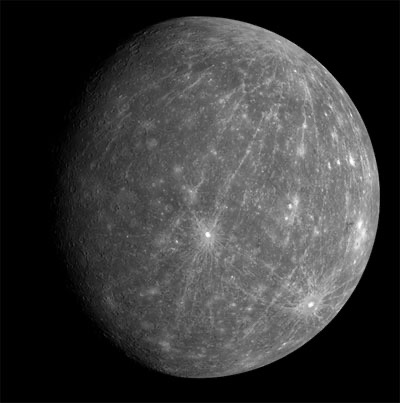
The solar system’s innermost planet is also its most bashful. Because it hugs the Sun at an average distance of 36 million miles, Mercury becomes an elusive world to spot from here on Earth. Whenever it does venture far enough away from the Sun, it will make a brief appearance in our skies for a few weeks each year, either low to the eastern horizon right before sunrise, or right after sunset low to the western horizon during the early evening. But on the morning of Monday, November 11th, Mercury will actually pass in front of the Sun’s disc, an event known as a “transit”. This is a great observing opportunity provided that you have access to a properly solar filtered telescope.
WHAT’S IT ALL ABOUT?
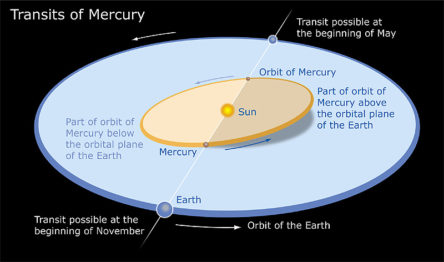 Several times a year, Mercury passes in between the Earth and the Sun (astronomers call these times, “inferior conjunction”), but because its orbit is inclined by 7-degrees relative to the Earth’s orbital plane, the alignment rarely results in a transit. In fact, transits of Mercury only happen about 13 or 14 times per century, and only during the months of May and November when Mercury’s orbital tilt allows it to cross the ecliptic. The ecliptic is the orbital plane of the Earth, moon, and other planets projected onto the sky; we see it as the path that the Sun makes as it traverses the sky over the course of a year. The last transit of Mercury was in May of 2016 and the one before that was in November of 2006. You’ll have to hang around until November 13, 2032 to see it happen again. We only ever see the inner planets, Mercury and Venus, transit the Sun and transits of Venus are even rarer, you’ll have to wait until December 11, 2117 to see that happen. I suggest you take advantage of this one while you can. Fingers crossed for clear skies!
Several times a year, Mercury passes in between the Earth and the Sun (astronomers call these times, “inferior conjunction”), but because its orbit is inclined by 7-degrees relative to the Earth’s orbital plane, the alignment rarely results in a transit. In fact, transits of Mercury only happen about 13 or 14 times per century, and only during the months of May and November when Mercury’s orbital tilt allows it to cross the ecliptic. The ecliptic is the orbital plane of the Earth, moon, and other planets projected onto the sky; we see it as the path that the Sun makes as it traverses the sky over the course of a year. The last transit of Mercury was in May of 2016 and the one before that was in November of 2006. You’ll have to hang around until November 13, 2032 to see it happen again. We only ever see the inner planets, Mercury and Venus, transit the Sun and transits of Venus are even rarer, you’ll have to wait until December 11, 2117 to see that happen. I suggest you take advantage of this one while you can. Fingers crossed for clear skies!
WHEN AND WHERE TO LOOK
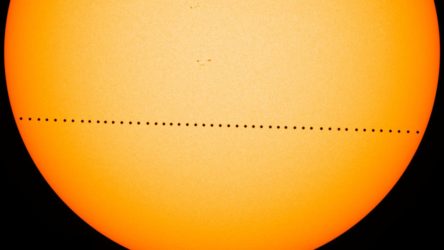 Here is a breakdown of the transit event times for the morning of November 11, here in Little Rock. These are lifted from the Time and Date website. If you live outside of our time zone, you can go the site and see when things are happening at your location: https://www.timeanddate.com/eclipse/transit/2019-november-11
Here is a breakdown of the transit event times for the morning of November 11, here in Little Rock. These are lifted from the Time and Date website. If you live outside of our time zone, you can go the site and see when things are happening at your location: https://www.timeanddate.com/eclipse/transit/2019-november-11
Australia and Asia will not be able to see it.
• 6:41 AM CST Sunrise, and the transit has actually just gotten started before then, so we miss out on what is known as “first contact”, the moment that Mercury first touches the Sun’s disc.
• 9:00 AM CST Mercury is officially at inferior conjunction
• 9:20 AM CST Mercury is now at its closest point to the Sun’s center.

• 12:02 CST Mercury is now leaving the Sun’s disc. This is the time to look for the cool optical illusion known as the “black drop effect”. As the planet touches the inner edge of the Sun’s disc, Mercury will briefly appear to elongate into a black teardrop-shape. We aren’t entirely sure about all the physics underlying this phenomenon, but it most likely has to do with how the light is being diffracted near the Sun’s edge. You can recreate the effect by using your fingers. Hold your index finger and your thumb close together as though you were about to pinch something, but don’t let them quite touch. Now, hold them up against a bright background and slowly bring them together. As you do so, before you allow thumb and finger to actually touch, you will see a dark bridge that connects them together. This is the kind of optical illusion I am talking about and it is a result of light being bent (diffracted”) and interfered around the edges of your fingers.
• 12:04 PM CST Mercury leaves the Sun’s disc and the transit it now over.
The entire sequence of events takes 5 hours and 25 minutes.
HOW TO SEE IT
In order to view the transit, you are going to need a telescope with a solar filter. If you don’t have one, check with your local astronomy club or science museum to see if they are offering any viewing opportunities. Here in central Arkansas, that would be the Central Arkansas Astronomical Society. You can visit their website at www.caasastro.org or you can drop them an email at info@caasastro.org
Solar eclipse glasses will not be helpful I’m afraid, Mercury is just too small to be visible. Nor will pinhole projections, used for viewing solar eclipses, yield any kind of satisfactory viewing experience. However, solar filtered binoculars might be an alternative, I have a pair that cost around $50 and I have used them for 2017 solar eclipse and for viewing sunspots. There are also filters that you can buy and attach to your binoculars. If you do decide to go the binocular route, I suggest that you mount them on a tripod to keep them steady.
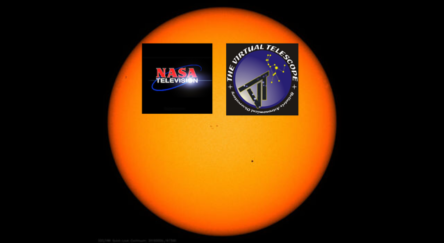 Should the weather not be cooperating during the time of the transit, you can always catch in online. Check out NASA TV (https://www.nasa.gov/multimedia/nasatv/index.html#public) or websites such as The Virtual Telescope Project (https://www.virtualtelescope.eu/2019/10/16/the-11-november-2019-mercury-transit-online-observing-session/)
Should the weather not be cooperating during the time of the transit, you can always catch in online. Check out NASA TV (https://www.nasa.gov/multimedia/nasatv/index.html#public) or websites such as The Virtual Telescope Project (https://www.virtualtelescope.eu/2019/10/16/the-11-november-2019-mercury-transit-online-observing-session/)
SOMETHING COOL TO THINK ABOUT
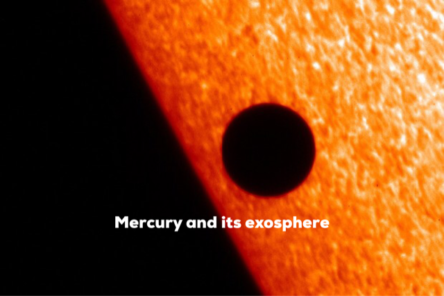 Until fairly recently, astronomers thought that worlds like the moon and Mercury lacked an atmosphere. Turns out that they do have atmospheres, albeit very thin ones known as a “exospheres”. In the case of Mercury, the exosphere is created when charged particles streaming from the Sun bombard the surface of the planet, knocking atoms off of the rocks. The heavier atoms fall back to the surface, but the lighter ones create the thin exosphere. During a transit, the sodium atoms in Mercury’s exosphere can be seen as an orange glow around the disc of the planet and astronomers can then study it with their telescopes and spectrometers. We are just now learning how to do this kind of thing with the atmospheres of exoplanets whenever we catch them transiting their parent stars. Plus, as Mercury transits the Sun, it causes a tiny dip in its overall brightness. We now have detectors that can monitor the dips in the brightness of distant suns to see if they have alien worlds orbiting around them. Currently, we know of over 4,000 exoplanets, many of these worlds having been discovered by detecting their transits across the face of their host star.
Until fairly recently, astronomers thought that worlds like the moon and Mercury lacked an atmosphere. Turns out that they do have atmospheres, albeit very thin ones known as a “exospheres”. In the case of Mercury, the exosphere is created when charged particles streaming from the Sun bombard the surface of the planet, knocking atoms off of the rocks. The heavier atoms fall back to the surface, but the lighter ones create the thin exosphere. During a transit, the sodium atoms in Mercury’s exosphere can be seen as an orange glow around the disc of the planet and astronomers can then study it with their telescopes and spectrometers. We are just now learning how to do this kind of thing with the atmospheres of exoplanets whenever we catch them transiting their parent stars. Plus, as Mercury transits the Sun, it causes a tiny dip in its overall brightness. We now have detectors that can monitor the dips in the brightness of distant suns to see if they have alien worlds orbiting around them. Currently, we know of over 4,000 exoplanets, many of these worlds having been discovered by detecting their transits across the face of their host star.